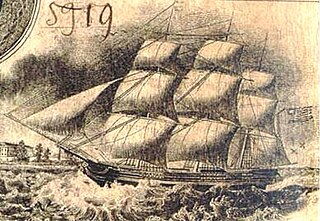 W
WThe Texan brig Archer was a two-masted brig of the Second Texas Navy from 1842-1846. She was the sister ship of the Wharton. Transferred to the United States Navy in 1846, she was sold for $450.
 W
WThe Texan sloop-of-war Austin was the flagship of the Second Texas Navy from 1840 to 1846. Commanded by Commodore Edwin Ward Moore, she led a flotilla in the capture of Villahermosa in 1840. After a period of inaction in port, Austin participated in the Naval Battle of Campeche in 1843. Austin was transferred to the United States Navy when Texas joined the United States in 1845, but was run aground and broken up in 1848.
 W
WThe Texan schooner Brutus was one of the four ships of the First Texas Navy (1836–1838) that during the Texas Revolution wreaked havoc on towns along the coast of Mexico, blockaded Mexican ports, and captured ships bound for Mexico with goods and munitions of war.
 W
WLaura is a former steamboat built in 1835, originating from a shipyard in Louisville, Kentucky.
 W
WThe Texas schooner Liberty was one of the four schooners of the First Texas Navy (1836–1838). She served in the Texas Navy for only about 6 months, capturing the Mexican brig Pelicano loaded with weapons for their army in Texas. Later that year, she sailed to New Orleans accompanying the wounded Sam Houston, where she was repaired. Texas was unable to pay for the repairs and the ship was sold in June, 1836, to pay for the cost of the repairs. This left the Texas Navy with only three ships.
 W
WThe Texan brig Potomac was a ship of the Second Texas Navy that never sailed as a warship. For a while, in 1838, she was the only ship in the Texas Navy. She was decommissioned in 1843.
 W
WThe Texan schooner San Antonio was a two-masted schooner of the Second Texas Navy from 1839-1840. She was the sister ship of the San Jacinto and the San Bernard. In 1840, San Antonio was part of the Texas Navy flotilla led by Commodore Edwin Ward Moore which was dispatched to assist Yucatecan rebels that had taken up arms against Mexico. In February 1842, while re-provisioning in New Orleans, the crew of the San Antonio mutinied and the Lieutenant was killed. This was the only mutiny in the history of the Texas Navy. That fall, the San Antonio sailed for Campeche and was never heard from again.
 W
WThe Texan schooner San Bernard was a two-masted schooner of the Second Texas Navy from 1839-1840. She was the sister ship of the San Jacinto and the San Antonio. In 1840, San Antonio was part of the Texas Navy flotilla led by Commodore Edwin Ward Moore which was dispatched to assist Yucatecan rebels that had taken up arms against Mexico. Returning to the Yucatan in 1841, San Bernard assisted in the capture of three Mexican prizes. Upon return to Galveston, San Bernard was driven ashore and was not repaired. When Texas joined the United States in 1846, San Bernard was transferred to the United States Navy and then sold for $150.
 W
WThe Texan schooner San Jacinto was a two-masted schooner of the Second Texas Navy from 1839 to 1840. She was the sister ship of the San Antonio and the San Bernard. In 1840, San Jacinto was part of the Texas Navy flotilla led by Commodore Edwin Ward Moore which was dispatched to assist Yucatecan rebels that had taken up arms against Mexico. In a storm, San Jacinto ran aground at Cayos Arcas and was wrecked. The crew were rescued by the flagship Austin.
 W
WThe Texan brig Wharton was a two-masted brig of the Second Texas Navy from 1839-1846. She was the sister ship of the Archer. Accompanying the Texas flagship, Austin, she defeated a larger force of Mexican Navy steamships in the Naval Battle of Campeche in May 1843. Transferred to the United States Navy in 1846, she was sold for $55.
 W
WThe Texan steamship Zavala was a Texas Navy ship in Texas' second Navy after the Texas Revolution. She was the first steamship-of-war in the Texas Navy.